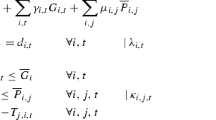Abstract
Greenhouse gas regulation aimed at limiting the carbon emissions from the electric power industry will affect system operations and market outcomes. The impact and the efficacy of the regulatory policy depend on interactions of demand elasticity, transmission network, market structure, and strategic behavior of generators. This paper develops an equilibrium model of an oligopoly electricity market in conjunction with a cap-and-trade policy to study such interactions. We study their potential impacts on market and environmental outcomes which are demonstrated through a small network test case and a reduced WECC 225-bus model with a detailed representation of the California market. The results show that market structure and congestion can have a significant impact on the market performance and the environmental outcomes of the regulation while the interactions of such factors can lead to unintended consequences.
Similar content being viewed by others
References
Azevedo I. L., Morgan M. G., Lave L. (2011) Residential and regional electricity consumption in the U.S. and EU: how much will higher prices reduce CO2 emissions?. The Electricity Journal 24(1): 21–29
Baldick R. (2003) Variation of distribution factors with loading. IEEE Transactions on Power Systems 18(4): 1316–1323
Borenstein S., Bushnell J., Stoft S. (2000) The competitive effects of transmission capacity in a deregulated electricity industry. RAND Journal of Economics 31(2): 294–325
Capros, P., Mantzos, L., Kolokotsas, D., Ioannou, N., Georgakopoulos, T., Filippopoulitis, A., et al. (1998). The PRIMES Energy System Model—reference manual. Document as peer reviewed by the European Commission, Directorate General for Research, National Technical University of Athens.
Cardell J. B., Hitt C. C., Hogan W. W. (1997) Market power and strategic interaction in electricity networks. Resource and Energy Economics 19(1–2): 109–137
Chen Y., Hobbs B. F. (2005) An oligopolistic power market model with tradable NO x permits. IEEE Transactions on Power Systems 20(1): 119–129
Cottle R., Pang J., Stone R. E. (1992) The linear complementarity problem. Academic Press, Boston, MA
Downward A. (2010) Carbon charges in electricity systems with strategic behavior and transmission. The Energy Journal 31(4): 1–6
Energy Information Administration. (2010). Annual Energy Review 2009. http://www.eia.doe.gov/aer/pdf/aer.pdf. Accessed 28 December 2010.
Environmental Protection Agency. (2007). Continuous Emission Monitoring System (CEMS) http://www.epa.gov/ttn/emc/cem.html. Accessed 10 May 2011.
Environmental Protection Agency. (2011). Integrated Planning Model (IPM). http://www.epa.gov/airmarkets/progsregs/epa-ipm/index.html. Accessed 10 May 2011.
Hughes, S. (2010). EPA sets timetable for greenhouse-gas rules. The Wall Street Journal http://online.wsj.com/article/SB10001424052748704278404576037730676096172.html. Accessed 29 December 2010.
Kolstad, J. T. & Wolak, F. A. (2003). Using environmental emissions permit prices to raise electricity prices: Evidence from the California electricity market. Technical report CSEM WP 113, University of California Energy Institute, Berkeley, CA.
McKinsey and Company. (2007). Executive Report. Reducing U.S. Greenhouse Emissions: How Much and at What Cost? http://ww1.mckinsey.com/clientservice/ccsi/pdf/US_ghg_final_report.pdf. Accessed 10 May 2011.
Barquin J., Boots M.G., Ehrenmann A., Hobbs B.F., Rijkers F.A. (2005) Network constrained Cournot models of liberalized electricity markets: The devil is in the details. Energy Economics 27(3): 495–525
Pang J.-S., Hobbs B. F., Day C. J. (2001) Properties of oligopolistic market equilibria in linearized dc power networks with arbitrage and supply function conjectures. In: Sachs E. W., Tichatschke R. (eds) System modeling and optimization XX. Kluwer Academic Publishers, Massachusetts, pp 113–142
Shao, M. & Jewell, W. (2010). CO 2 emission-incorporated AC optimal power flow and its primary impacts on power system dispatch and operations. MN, USA: Power and Energy Society General Meeting, 2010 IEEE.
Tsao C.-C., Campbell J., Chen Y. (2011) When renewable portfolio standards meet cap-and-trade regulations in the electricity sector: Market interactions, profits implications, and policy redundancy. Energy Policy 39(7): 3966–3974
Wei J.-Y., Smeers Y. (1999) Spatial oligopolistic electricity models with Cournot generators and regulated transmission prices. Operations Research 47(1): 102–112
Yao J., Adler I., Oren S. S. (2008) Modeling and computing two-settlement oligopolistic equilibrium in a congested electricity network. Operations Research 56(1): 34–47
Yu N.-P., Liu C.-C., Price J. (2010) Evaluation of market rules using a multi-agent system method. IEEE Transactions on Power Systems 25(1): 470–479
Author information
Authors and Affiliations
Corresponding author
Rights and permissions
About this article
Cite this article
Limpaitoon, T., Chen, Y. & Oren, S.S. The impact of carbon cap and trade regulation on congested electricity market equilibrium. J Regul Econ 40, 237–260 (2011). https://doi.org/10.1007/s11149-011-9161-4
Published:
Issue Date:
DOI: https://doi.org/10.1007/s11149-011-9161-4
Keywords
- Power market modeling
- Electric power markets
- Cap-and-trade programs
- Carbon dioxide emissions
- Market power




